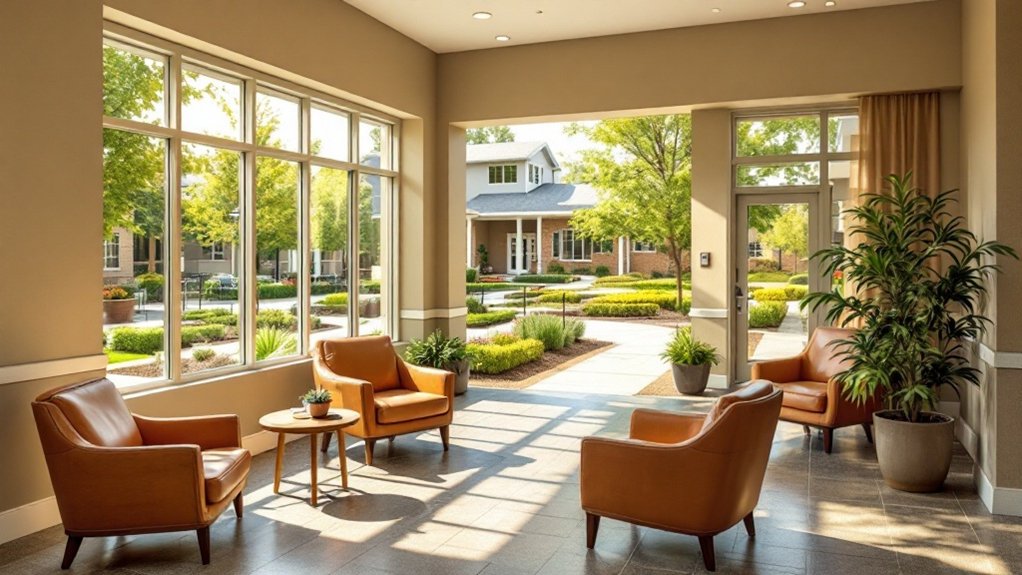When evaluating memory care communities for Alzheimer's patients in 2025, you'll find specialized facilities offering extensive cognitive support services that demonstrate 32% lower hospitalization rates compared to traditional assisted living. The most effective communities maintain staff-to-resident ratios of 1:6, provide 25 hours of annual specialized training, and feature advanced monitoring systems in homelike settings. With 70% of Alzheimer's patients requiring specialized care, superior facilities incorporate multidisciplinary approaches and evidence-based design elements that warrant deeper examination of their innovative care protocols.

Nearly seventy percent of Americans with Alzheimer's disease require specialized memory care services to maintain their quality of life and cognitive function, making the selection of an appropriate facility a critical healthcare decision. Current market analysis indicates that memory care facilities demonstrating superior outcomes consistently feature 24-hour supervision, personalized cognitive support programs, and extensive safety protocols, including advanced tracking systems and secured entry points. Trained staff available monitor residents continuously to ensure safety and address immediate needs.
Industry data reveals that specialized memory care communities reduce hospitalization rates by 32% compared to traditional assisted living facilities, while implementing multidisciplinary approaches that incorporate both medical and therapeutic interventions. These facilities' enhanced staffing ratios, typically maintaining one caregiver per six residents, enable more individualized attention and rapid response to behavioral changes or medical concerns. The trend toward group home settings in residential neighborhoods is becoming increasingly prevalent as an alternative to institutional care. Well-designed facilities emphasize structured activities that promote emotional well-being and cognitive stimulation through daily engagement.
Contemporary memory care environments have evolved to incorporate evidence-based design elements, featuring both small-scale, homelike settings and technologically advanced monitoring systems. Leading facilities demonstrate exceptional performance metrics in cognitive engagement through structured activities, including horticultural therapy, music programs, and specialized exercise regimens, all tailored to preserve residents' functional abilities and promote social interaction.
The most effective memory care communities differentiate themselves through extensive staff training programs, with caregivers receiving an average of 25 hours of specialized dementia care education annually. These facilities typically maintain lower resident-to-staff ratios and employ on-site geriatric psychiatrists, fostering improved behavioral management and reduced psychotropic medication usage.
Specialized training and lower staff ratios in memory care facilities lead to better behavioral outcomes and reduced reliance on medications.
Financial analysis indicates that while memory care services command a 15-30% premium over standard assisted living costs, the investment typically yields superior outcomes regarding reduced acute care episodes and extended aging-in-place capabilities. Leading facilities are increasingly incorporating technological innovations, including artificial intelligence-driven monitoring systems and personalized cognitive stimulation programs, which correlate with improved quality-of-life metrics and decreased rates of decline in activities of daily living.
The most successful memory care communities demonstrate exceptional performance in key evaluation criteria, including staff retention rates exceeding 80%, implementation of evidence-based cognitive support programs, and maintaining extensive family communication protocols that facilitate informed decision-making and ongoing care coordination.
Frequently Asked Questions
How Can I Help My Loved One Adjust to a New Memory Care Facility?
Structure your loved one's shift through consistent daily schedules incorporating familiar possessions, while maintaining frequent communication with staff regarding care needs.
You'll optimize adjustment by scheduling regular family visits, participating in facility activities, and personalizing their living space.
Implement evidence-based strategies like establishing routines during peak cognitive hours and integrating memory cues through strategic environmental design.
What Alternative Therapies Are Available for Alzheimer's Patients in Memory Care Communities?
Modern memory care facilities offer diverse evidence-based alternative therapies, including art sessions that boost cognitive function through creative expression, music interventions that enhance mood regulation and memory recall, and animal-assisted programs featuring trained therapy animals.
You'll find specialized movement therapies like chair yoga and tai chi, while nature-based interventions incorporate therapeutic gardening and guided outdoor activities to stimulate sensory engagement and reduce agitation.
Can Married Couples Live Together in Memory Care Facilities?
You'll find many memory care facilities now accommodate married couples through various living arrangements, including shared apartments and integrated care models.
Leading communities offer flexible options where both spouses can receive individualized care levels while maintaining their relationship.
Your opportunities include specialized two-bedroom units, companion suites, and hybrid arrangements where one spouse resides in assisted living while the other receives memory care services within the same community complex.
What Happens if Our Financial Resources Run Out During Memory Care?
If you exhaust your financial resources during memory care, you'll typically shift to Medicaid coverage, which requires spending down assets to qualifying levels.
You'll need to relocate to a Medicaid-certified facility unless your current community accepts Medicaid conversion.
Consider establishing a Qualified Income Trust or exploring veterans' benefits to supplement care costs.
Your facility's social worker can guide you through available government assistance programs and alternative funding options.
How Often Should Family Members Visit Residents in Memory Care Communities?
You should visit memory care residents 2-4 times monthly to maintain meaningful connections while balancing caregiver burnout risks.
While individual circumstances vary based on the resident's cognitive status and facility programming, establishing consistent visiting patterns improves outcomes.
Factor in your work schedule, travel distance, and the resident's daily routines to create a sustainable visitation plan that aligns with facility activities and your loved one's peak engagement periods.









